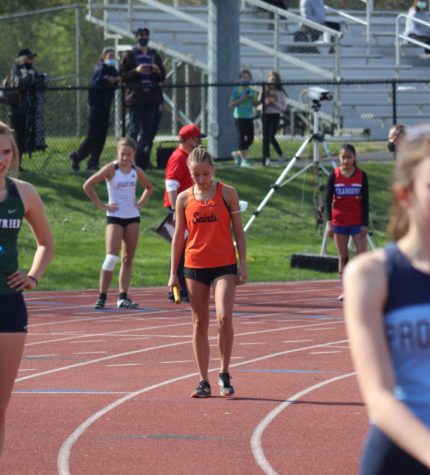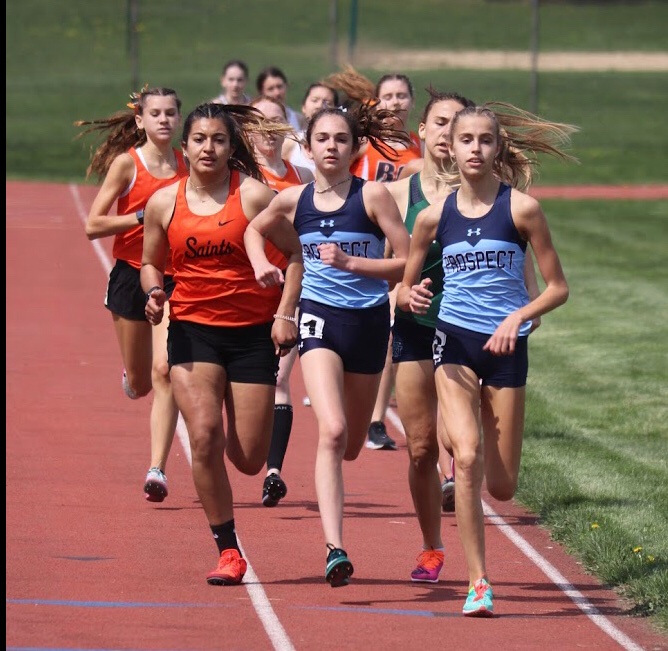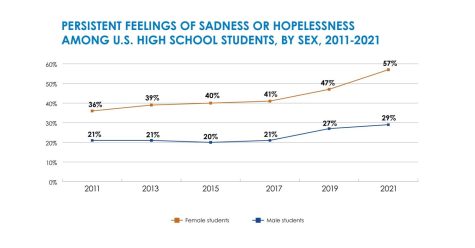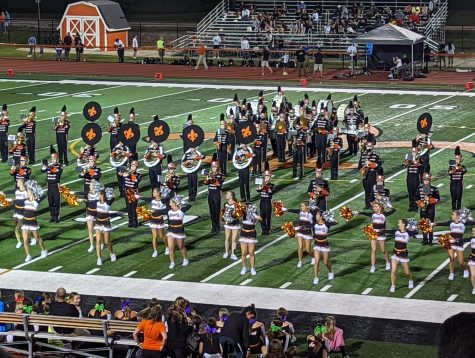Competing Priorities
Female athletes often face negative body image worries due to emphasis on physical appearances
East and Prospect runners race towards the finish line at the Carol Koszola invite at Lake Park High School. Photo by Dana Andelman.
May 11, 2021
In a society where women are frequently judged by their appearance rather than talent, female athletes are increasingly more likely to be criticized based on their looks, making them prone to developing bad body image. According to womenshealth.gov, body image includes “what you think and feel about your appearance and how you judge your own self-worth.” Body image is based on how someone perceives themselves to look and how they think others perceive their appearance.
For female athletes, socio-cultural and sport-specific factors have a large influence on body image. Negative body image can put athletes at higher risk for developing mental health conditions like eating disorders and depression.
Why are female athletes prone to developing bad body image?
Ever since females began participating in professional sports, they have been criticized for not appearing feminine or proper enough.
In 1953, New York Times writer Arthur Dailey stated that he would consider eliminating women from the Olympics. He wrote, “There’s just nothing feminine or enchanting about a girl with beads of perspiration on her alabaster brow, the result of grotesque contortions in events totally unsuited to female architecture.”
Despite the decades that have passed since then, female athletes still face pressure to maintain unrealistic standards.
In 2013, Mary Cain, the youngest American professional runner, joined the formerly world-renowned running program in the country, the Nike Oregon Project.
Females athletes’ increased risk of developing bad body image often stems from the pressure of coaches.
17-year-old Cain trained alongside the fastest athletes in the world. The program’s coaches believed that the thinner she became, the better she would perform.
In an Op-Ed published by Vice News, Cain explained how she endured weigh-ins in front of teammates and restrictive diets.
“I ran terribly during this time,” Cain reccounted. “I broke 5 bones.”
The increased risk of developing negative body image among female athletes can also stem from sports uniforms.
In a study performed by Sage Publishing about the impact of uniforms on female college volleyball athletes, a 20-year-old player stated “If I had a choice I would definitely change the tightness of the uniforms… because it does demote your confidence, and it does make you compare yourself to other teammates and other athletes that look better in their uniforms.”
Along with sport-specific pressures, the increased risk of bad body image stems from endorsements. Securing endorsements can be a major determining factor for whether or not a female can financially support herself as a professional athlete.
However, endorsements for females are often based on appearance rather than performance. Despite her better performance on the court, it wasn’t until 2016 that world-class tennis player Serena Williams earned more money through endorsements than Russian tennis player Maria Sharapova. This shift came after Sharapova was publically found guilty of drug use.
How does bad body image affect performance?
Being an athlete requires extensive training to perform at the highest level. However, society’s pressure on female athletes to look a certain way creates an internal battle to choose between performance or appearance.
According to society’s standards, if a female athlete wants to perform to the best of her abilities, she will not be able to achieve the unattainable standards that the ideal body type consists of: having a flat stomach and small waist, yet still having society’s ideal curves. If she achieves a weight and body fat percentage low enough to meet society’s standards, her performance will suffer.
An article published by the Yale Daily News elaborates on this challenge. Yale volleyball players stated that they were worried about having “man arms” and looking “way too jacked.” Soccer players faced similar struggles, as women’s soccer midfielder Margaret Furlong explained the fear of developing “soccer legs” due to the immense leg strength needed to succeed in the sport.
Female athletes that develop bad body image and try to alter their appearance face serious health risks. According to womensrunning.com, underfueling can lead to a decrease in endurance and muscle. It can also lead to low bone density, which increases the risk of injury, along with a weaker and slower heart, making it difficult to circulate blood throughout the body.
If female athletes achieve society’s ideal beauty standards while putting themselves through the extreme rigor of workouts and competition, their ability to perform will diminish while their level of injury will increase.
A Desire for Change
Despite these struggles faced by many female athletes, not much has been done to resolve these issues.
In the Yale Daily News article, two golf players opened up about their past experience with body image issues and eating disorders. Yet when women’s golf head coach, Chawwadee Rompothong, was asked if women on the team dealt with these issues, she claimed she was not aware of any athletes who had.
Many college athletes are calling for mental health professionals specifically trained to assist athletes, as the challenges student-athletes face are much different than a typical college student.
Yale long distance runner Emily Barnes expressed the importance of supportive coaches, as many avoid these types of topics, increasing the risk of female athletes developing unhealthy relationships with their bodies.
In that same article, former Yale basketball player Meredith Boardman explained how representation in the media is another major step needed to resolve this issue.
“Being able to see more female athletes in the media embracing their athletic bodies can help shift the narrative away from ‘unhealthy and unrealistic’ body expectations,” Boardman explained in the Yale Daily News.
If actions are not taken soon, female athletes’ performance will continue to suffer. This change in performance is not because of a lack of ability, but because of society’s harmful, unrealistic standards that prevent female athletes from competing to the best of their abilities.

A Student’s Perspective
Junior Gia Klasa is a member of the track and field and cross-country teams at East. She says that many girls in the running community have insecurities about their bodies.
Q: How have your athletic experiences impacted your perception of your own body?
A: “Many girls that I know including myself have, or are struggling with body image.
Running has always bee notorious for how women are depicted in the sport no matter in cross country or track. It’s always the same picture, slim, abs, tiny strong butt, and lean legs.
So with that image of how a runner has to look like according to society is stuck in most of teenage/young runners’ heads. For a high school runner it’s like, ‘Oh shoot I forgot to do my 20 minute ab workout and lifting weights after my 6-8 mile run, I have to look lean and have abs, I mean, I am a runner, right?”
Body image overall, specifically in women’s running, is completely skewed and in a way toxic. I am very fortunate to have a group of girls that understand and are willing to talk openly about body image, body insecurities, and anything in between. This struggle of a perfect body image in women’s running is so negative, yet in a way brings us together because we are all able to relate in different or in similar ways.
I’ve been running for over…6 years and had problems with my body image and comparing myself to other girls or professional women athletes, so it has been a struggle and a hard journey to overcome.
Body image will forever be something that affects women, and we just have to stand together and be supportive of one another.”










